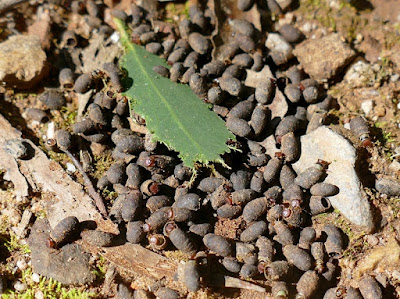I had no intention of talking about leaf beetles today - indeed I scarcely knew anything about them and the idea had never occurred to me. Until Sunday.
On Sunday I was walking with some like-minded people along a quiet road in the Tallaganda Ranges a little to the east of Canberra. The Tallagandas contain some beautiful wet eucalypt forest, a reasonable proportion of which has now been preserved from the creeping blight of exotic pine plantations and dedicated as Tallaganda National Park.
 |
| Eucalyptus obliqua, E. viminalis and Fishbone Ferns Blechnum spp., Tallaganda NP. |
On the road we found a busy crowd of odd-looking little animals, seemingly in mud-like shells, demolishing a eucalypt leaf - I was at a complete loss to explain them, to my embarrassment. There wasn't much left of their leaf, but I was concerned for their safety on the road, quiet though it was, and tried to move them and the leaf to the edge of the road. They were much more active than they first seemed however and all tumbled off to the side and proved impossible to move without risking damage to them.
 |
| A very odd little gathering! |
Back in Canberra I consulted Kim Pullen, an entomologist with CSIRO (for those outside Australia, this is the Commonwealth Scientific and Industrial Research Organisation, an icon of Australian research, though shamefully starved of funds by recent governments). He put me firmly on the right track, on which I've since done a little more of my own research, though readily available information isn't plentiful.
However I think I've got enough to share a little story which I found fascinating. Our little characters are leaf beetle larvae, Family Chrysomelidae, subfamily Cryptocephalinae. Normally we don't worry too much about sub-families for day to day use, but when species numbers are as high as they are in insect families, and notably among beetles, it is a practical necessity. As a case in point, there are some 700 species of Cryptocephalines in Australia alone.
First, a little background (bearing in mind I claim no expertise in matters invertebrate). The leaf beetles, Chrysomelidae, contain at least 3000 species in Australia, in more than 250 genera. Both adults and larvae specialise in eating plant tissue, including, as you'd expect in Australia, both eucalypt and acacia leaves.
 |
| A leaf beetle, probably of the same subfamily as our subjects, effectively chewing an Eremophila leaf, Whyalla Conservation Park, South Australia. |
The best-known are probably the numerous species of the genus Paropsis, or tortoise beetles. A major part of the secret to their success is in being one of the few groups of organisms in the world which have managed to unravel the chemical binding of proteins to the tannins in eucalypt leaves. These greatly limit the availability of essential nitrogen to those munching on them, making them pretty unattractive to most leaf-eaters.
Another Chrysomelid is well-known to orchid growers - the Orchid Beetle Stethopachys formosa (subfamily Criocerinae) specialises in eating orchid flowers, notably the summer flowering hyacinth orchids, Dipodium spp. They really appreciate the nice warm conditions in greenhouses!
 |
| Orchid beetle on lunch - Dipodium punctatum, Rosedale, south coast New South Wales. |
So, what's the story of our little friends on the Tallaganda road? Kim Pullen tells me that the only way to even allocate them to a genus would be to raise them to adulthood, but my fostering skills are not up that, even if I was willing to rip them from their friends and family. As the the female beetle laid each egg on the ground, she caught it in the 'foot' of her rear legs and coated it in droppings, which are composed of eucalypt leaf material. When the egg hatched, the little beetle larva broke a hole at the front of the case and with the assistance of its front 'legs' moves about the forest floor eating the litter. I am told by Kim that Dr Chris Reid of the Australian Museum in Sydney, an expert on Chrysomelids, considers them an important player in the cycle of litter breakdown in eucalypt forests
An enlarged view of a section of the above photo shows some of the larvae protruding from their mobile homes. These homes provide both physical protection and effective camouflage in the litter.
As they grow they add to the case with their own droppings, and when the time comes they pupate within it, eventually emerging as an adult beetles.
A small story in the bigger scheme of things, but it fascinated me and I hope you found something of interest here too.
BACK ON TUESDAY














































